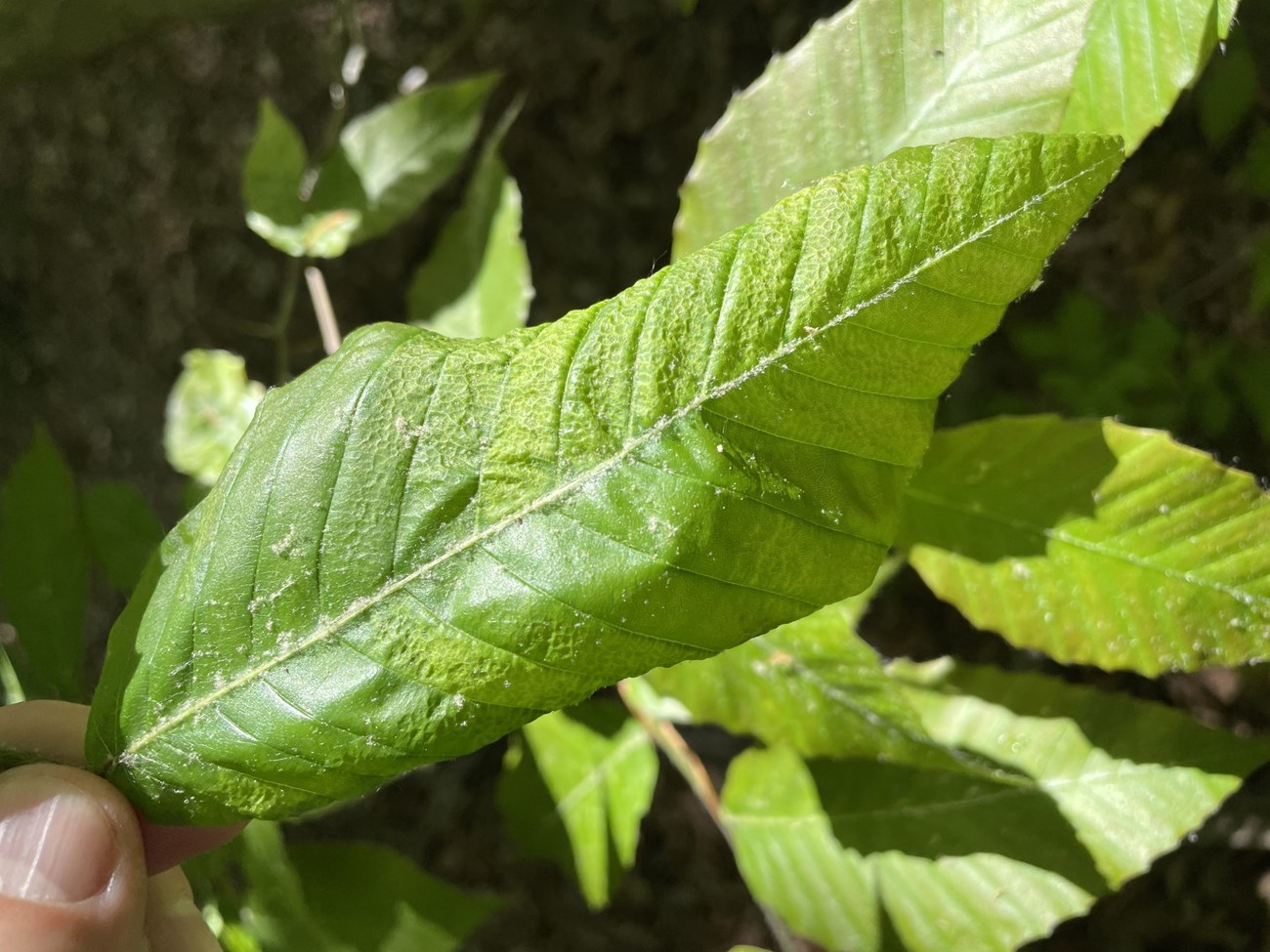Last updated: May 28, 2024
Article
Beech Leaf Disease: Mistaken Identity

NPS/Brolis
An Emerging Threat
Beech leaf disease (BLD) is an emerging threat to beech trees (Fagus sp.) in the National Capital Region (NCR) and beyond. Since beech is the most common tree species found in the NCR (as of 2023) it is helpful to learn how to identify BLD and avoid falling for look-alikes!
First, Make Sure it's a Beech

NPS/Vinduska (top) NPS/Sheline (bottom)
Distinctive features of beech trees include:
- Oval-shaped leaves with serrated edges
- Yellow or bronze leaves that stay on the tree through the fall and winter
- Smooth, gray bark
- Leaf veins arranged in an alternating pattern
Learn more about identifying beech trees: How to Identify the American Beech

NPS/John Zuke
Beech Leaf Disease: Signs and Symptoms
Beech Leaf Disease (BLD) causes very distinctive symptoms. Evidence of BLD on beech trees can be found in the canopy; diseased leaves will show characteristic dark banding between the veins of the leaf. Leaves also tend to be wrinkled and misshapen, which worsens as the disease progresses.

NPS/Brolis
Other Pests Affecting Beech
Beech trees can suffer from various afflictions that can be confused for BLD. It is important to make a distinction between different pests and pathogens to assess the health of beech trees.
Woolly Aphid
Woolly aphids (Eriosoma lanigerum) are a common forest pest that changes beech leaf appearance. These small insects cause beech leaves to develop pale or yellow banding between veins of the leaf. They can also leave behind pale spotted patterns along these leaves.

NPS/Brolis
Beech Erineum Mite
Another beech pest is the beech erineum mite (Acalitus fagerinea). These microscopic mites cause a dark spotting pattern of galls, or small growth deformities on the leaf. This pattern can appear similar to BLD, but the discoloration creates less organized bands on the leaf. These spots can also be raised or lighter in color depending on the severity of infection.

Charles Smith (Strick Tree Services)
Leaf Curling Aphid
A more generalized pest that sometimes attacks beech is the leaf curling aphid. This term refers broadly to several types of aphids, which attack beech as well as other tree species. These aphids cause leaves to curl along their edges and can cause yellowing between veins of the leaf that can be mistaken for BLD. Sometime aphids will leave behind cast skins on the underside of leaves that appear as brown bumps.

NPS/Brolis
What to do when you spot BLD (and other pests)!
- Report any pest sightings to local county authorities or department of agriculture. For good measure, you can also report them on iNaturalist.
- Consult with local forestry experts and ISA Certified Arborists for advice and assistance on tree-related issues.
Further Reading
- Carta, L.K., Handoo, Z.A., Li, S., Kantor, M., Bauchan, G., McCann, D., Gabriel, C.K., Yu, Q., Reed, S., Koch, J., Martin, D., and Burke, D.J. 2019. Beech leaf disease symptoms caused by newly recognized nematode subspecies Litylenchus crenatae mccannii (Anguinata) described from Fagus grandifolia in North America. Forest Pathology.
- Chatfield, Jim and Boggs, Joe. 2018. Ohio State University Extension. Diagnostics of Beech Leaf Disease: The Ultimate Beech Read
- National Park Service. 2022. Beech Trees in the National Capital Area
- US Forest Service. 2022. Pest Alert: Beech Leaf Disease
- Washinton University Arboretum. 2024. Washington University in St. Louis. How to Identify the American Beech
Tags
- antietam national battlefield
- catoctin mountain park
- chesapeake & ohio canal national historical park
- george washington memorial parkway
- harpers ferry national historical park
- manassas national battlefield park
- monocacy national battlefield
- national capital parks-east
- prince william forest park
- rock creek park
- wolf trap national park for the performing arts
- ncrn im
- ncrn
- forest pests
- forests
- american beech
- fagus
- nature
- bld
- beech leaf disease
- leaf curling aphid
- woolly aphid
- beech erineum mite
- erineum mite
- tree pests
